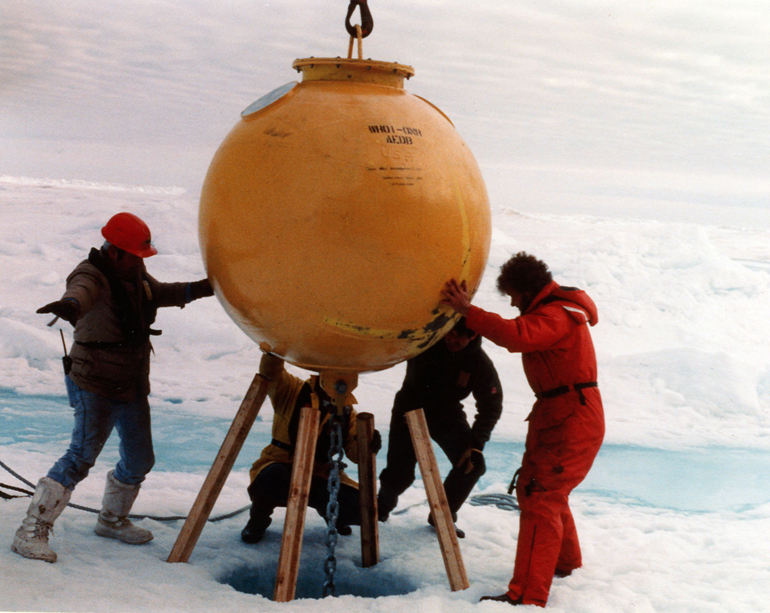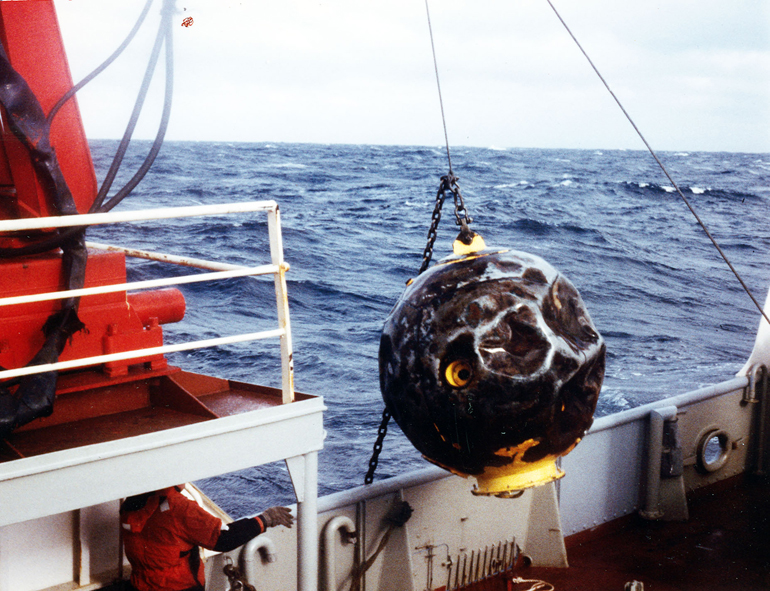The Arctic Environmental Drifting Buoy (AEDB)
Abstract
There are strong reasons to gather data on polar oceanography and climatology in real time using fully automated, unattended instrumentation systems for long periods; particularly during the inaccessible winter months when moving ice is extremely hazardous. We deployed an Arctic Environmental Drifting Buoy (AEDB) on 4 August 1987 at 86 7' N, 22 3' E off of the FS Polarstern on a large 3.7 m thick ice island. The AEDB consisted of 2 major components: a 147 cm diameter surface float housing ARGOS transmitters and a data logger for ice-profiling thermistors, and a 125 m long mooring line attached to the sphere and fed through a 1 m diameter ice hole. Along the mooring were deployed 2 fluorometers, conductivity and temperature loggers, an Acoustic Doppler Current Profiler (ADCP), a current meter, and a time-series sediment trap/micor-filter pump/transmissometer unit. The AEDB proceeded southwesterly with the Transpolar Drift at an average speed of 15.3 km/day, with a maximum speed of 88.8 km/day. On 2 January 1988, the AEDB dropped into the water while passing through the Fram Strait and for the remaining drift period was either free-floating on the water surface or underneath the sea ice. Throughout this period, the transmitters onboard successfully transmitted position, temperature, and strain caused by the ice on the sphere. Although the sediment trap package was lost during the drift, valuable data was collected by the other instruments throughout the experiment. The ice thermistor data was used to determine oceanic heat flux, while continuous ADCP observations over the Yermak Plateau provided a wealth of information for understanding internal waves in the ice-covered ocean. The buoy was recovered by the Icelandic ship R/S Arni Fridriksson on 15 April 1988 at 65 17' N, 31 38'W, off southeastern Greenland, completing 3,900 km of drift in 255 days.
Highlights of the 1987-88 AEDB Experiment
- The desire to develope a multi-sensor automated station which could be deployed as an ice-tethered mooring system, survive in Marginal Ice Zone (MIZ) conditions, and also function as a surface float in the open ocean for a short period of time prior to retrieval, was realized in the Arctic Environmental Drifting Buoy (AEDB).
- The drift track of the AEDB closely followed the predicted track within the expected time, based on previous Transpolar Drift work and models.
- For deployment of the AEDB mooring line, a method was devised using a CRREL hot water drill ring to drill a 1 m diameter hole in a 4 m thick multiyear icefloe. While the bow crane of the FS Polarstern was used for removal of the ice plug in this instance, other means could be used in other circumstances.
- The ARGOS location system was used not only to determine the position of the buoy during the experiment, but also to telemeter essential engineering data. Due to the polar orbits of the ARGOS satellites, 94% of the received transmissions were spaced less than 105 minutes apart. Characteristics of the drift, including speed, were calculated from the locations.
- The temperature, strain gauge and battery information telemetered from the surface sphere was necessary for the near real-time determination of the physical condition of the surface float in the ice and ocean. Furthermore, these observations are being used to improve the design of the surface float as part of the 1991 Ice-Ocean Environmental Buoy Program (IOEB).
- Data from ice thermistor chains was collected by a logger in the surface float until the icefloe broke apart. Upon retrieval, this information was used in the calculation of oceanic heat flux between the ocean and ice (Perovich et al., 1989).
- Nearly 500 kg of internally recording mooring instrumentation hung below the AEDB sphere. Valid data was retrieved from two fluorometers and an Acoustic Doppler Current Profiler (ADCP), but not from a C/T recorder and a seawater thermistor logger which both malfunctioned. The ADCP results were used to investigate the climatology and dynamics of internal waves under the sea ice (Padman, et. al. 1992, Pleuddemann, 1992).
- The deepest segment of the AEDB mooring system was lost during the drift, consequently data from those instruments were not recovered. In the IOEB experiment, nearly all of the instruments on the mooring line were configured to transmit their data via ARGOS.

